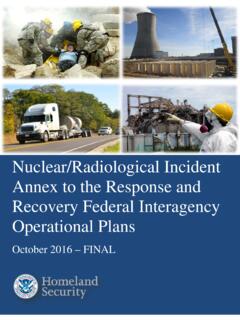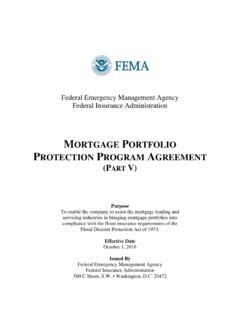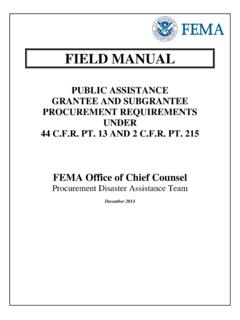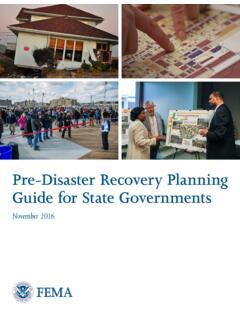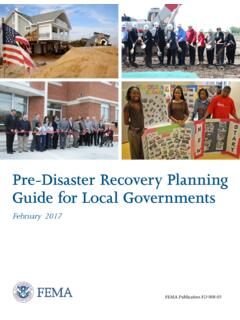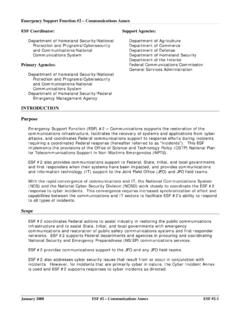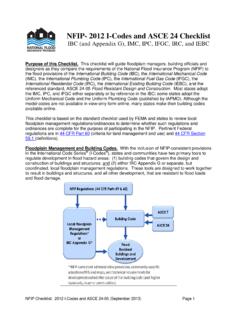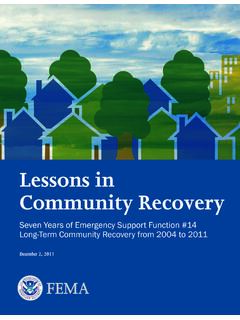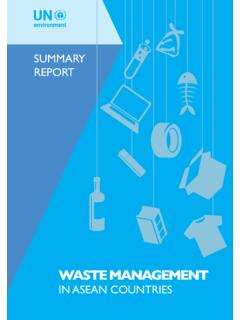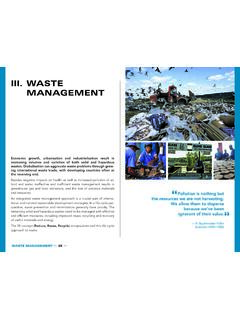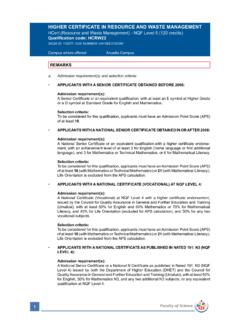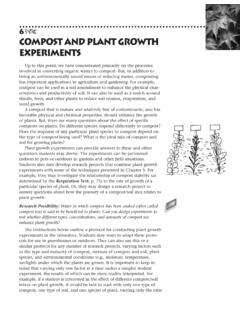Transcription of Alternative Techniques to Riprap Bank Stabilization - FEMA
1 Engineering With NatureAlternative Techniques to Riprap Bank StabilizationEngineering With NatureAlternative Techniques to Riprap Bank StabilizationContentsIntroduction ..7 Hamakami Strawberry Farm ..11 Riverview Road ..13 Eatonville Log jams ..15 Burley Creek Brush Mattress ..18 Everson Overflow ..20 Hiddendale ..22 Old Tarboo Road Bridge ..24 Black Lake Drainage Ditch ..27 Little Washougal Creek ..29 Schneider Creek ..31 Conclusion ..34 AcknowledgementsEn g i nE Er i n g Wi t h na t u rE 7 IntroductionWe have always endeavored to harness and manipulate our environment. Efforts to shape or restrict nature often involve mechanically or artifi-cially forcing our surroundings to bend to our will. Sadly, many of these activities have serious effects. Clear cutting forests, pollution, endanger-ing entire species or simply driving them to extinction are just some of the major impacts.
2 As we grow and develop technologically and as a society, we often overlook just what we are doing to the land around us, frequently until it is too the past century, the Pacific Northwest has seen a significant amount of development in the areas of agriculture, housing, urbaniza-tion and population. The 12 counties spanning the area of Puget sound in Washington State alone have seen growth in numbers of up to 4 million people since the 1950s. This continuing expansion has put increased pres-sure on the multitude of rivers, streams and other bodies of water that festoon the region, and growing presence is having a marked impact on those more development this area undergoes, the more we are forced to restrict and inhibit the environment, in particular the varying and numerous waterways that surround us. While land erosion, stream migration and even flooding are natural processes, they can cause havoc when occurring near human populations.
3 This has led to the creation of a number of measures to control or eliminate such hazards. Unfortunately, while many of these Techniques solve the immediate problem, they are not always the safest or most environmentally conscious choice for the , or hard armoring, is the traditional response to controlling and minimizing erosion along shorelines or riverbanks. As demonstrated by past multiple disasters in Washington State, the Department of Homeland Security s Federal Emergency management Agency ( fema ) has provided funding assistance for the repair to these Riprap facilities.* The very nature of having to repair these facilities counters the popular engineering belief that Riprap is the best solution for mitigating stream bank erosion. * Funding is contingent upon eligibility criteria established under the Robert T.
4 Stafford Disaster Relief and Emergency Assistance Act, as amended8 En g i nE Er i n g Wi t h na t u rERiprapPut simply, Riprap is the layering of rocks (angular rocks generally being preferred,) along a threatened area to counteract the constant wearing away of land brought about by repetitive hydrologic activity. Whenever waves or moving waters meet unprotected soil, there will always be ero-sion. Covering exposed soil with rock helps protect it from being washed away, securing an embankment against further erosion. Problems arise because the effects of Riprap do not stop at the point of installation. When positioned along a section of riverbank, for example, Riprap has a number of negative impacts on the surrounding environ-ment. Riprap tends to increase the speed of water flow along an armored reach, as the water has no points of friction to come up against and nothing to slow it down.
5 This additional strength of flow presents issues further downstream from a Riprap protected bank, as water is deflected off the Riprap and directed at other points of riverbank. The increased strength and speed of the water only increases erosion suffered at these new locations, the typical result of which is the necessity of installing additional armoring, which merely moves the problem further down the impedes the natural functions of a riverbank or shoreline, as it interrupts the establishment of the riparian zone, or the point of interface between land and flowing water. A properly functioning riparian zone is important for a number of reasons; it can reduce stream energy and minimize erosion; filter pollutants from surface runoff via biofiltration; trap and hold sediments and woody debris, which assists in replenishing soils and actually rebuilding banks and shorelines; and it provides habitat diversity and an important source of aquatic nutrients.
6 Not to mention, a naturally functioning riparian zone simply looks aspect of Riprap is its considerable effect on wildlife, specifically fish that live in and utilize streams and rivers where eroding banks have undergone armoring. While erosion can cause potential problems for fish, especially in high-silt loca-tions, the installation of Riprap leads to other, more significant, issues. When Riprap is the primary or only form of riverbank Stabilization measure, the end result is typically a uniform, smooth channel, with no complexity. This means that there are no areas of vegetation either in or overhanging the water, leaving fish at risk from predation. In ad-dition, a lack of riverbank diversity denies fish a place to seek refuge during periods of high-water, which often results in their being washed out of a fast moving system during flooding.
7 Riprap causes other, albeit less sig-nificant, problems as well. In areas of low vegetation, when exposed to direct sunlight, the rocks that com-prise Riprap can reflect light into En g i nE Er i n g Wi t h na t u rE 9the water, which increases water temperatures to an unhealthy degree for fish. Riprap also tends to suffer from structural integrity issues during and after high-water events. Losing rocks to high water or fast flows, a Riprap structure will soon begin to fail in its purpose. Once the soil that the Riprap is designed to protect is exposed, the damage continues as before its installation. This possibility requires constant monitoring and maintenance, which ultimately becomes expensive and TechniquesThe old saying goes the more things change, the more they stay the same. This adage, in many ways, can be applied to the discussion of riverbank Stabilization .
8 As technologies and Techniques have advanced in finding ways to secure our land from the constant ravages of erosion, we begin to see that perhaps modernizing these efforts might not be the only way to approach these issues. Nature has always been capable of taking care of itself. Long before we began manipulating our environment, nature has run its own course. Is it possible, then, that we can look to nature for examples to follow in mak-ing life near eroding or flood-prone waterways less risky while leaving as minimal a footprint as possible? Proponents of environmentally conscious and responsible construction believe so. As the realities and consequences of Riprap and hard armoring river-banks and shorelines have come to light, there are those who have begun to work towards changing the traditional approaches to erosion and flood control.
9 New and old engineering Techniques are being introduced regularly that incorporate natural functionality with modern technology and design. Bio-engineering, hydro-seeding, controlled planting and the construction of engineered logjams are just some of the many efforts be-ing taken to demonstrate the successful options that exist in the pursuit of land preservation and increased En g i nE Er i n g Wi t h na t u rEPurposeStandard engineering calls for hard armoring an eroding bank. Lately, the tide has turned on the accepted practice of hard armoring due to public conscience of the eroding environment we live in. The 10 stories in this booklet represent a handful of successful alternatives to riverbank Stabilization that have been taken throughout Western Washington. While this collection is in no way complete, it offers a comprehensive look at some of the varied Techniques that are available for consideration.
10 These best practices illustrate the fact that we can manipulate streams and rivers without completely overriding nature s design, that indeed, it is possible to work hand in hand with nature to make living by the water not only viable, but much safer and secure in the long run.!>!>!>!>!>!>!>!>!>!>5555555555555555 5555 HiddendaleRiverview RoadSchneider CreekEverson OverflowEatonville LogjamsLittle Washougal CreekOld Tarboo Road BridgeHamakami Strawberry FarmBlack Lake Drainage DitchBurley Creek Brush MattressYaki maYaki maKingKingChelanChelanLewisLewisKittitas KittitasOka noganOka noganSka gitSka gitPiercePierceKlicki tatKlicki tatClallamClallamWhatco mWhatco mJefferso nJefferso nSnohomi shSnohomi shSka ma niaSka ma niaGra ntGra ntCowlitzCowlitzGra ys Harb orGra ys Harb orMaso nMaso nPacificPacificDouglasDouglasClarkClarkB entonBentonThurst onThurst onKitsa pKitsa pWahki aku mWahki aku mIsl andIsl andSan Ju anSan Ju anGreen RiverNooksack RiverBi gQuilcene RiverKe ntYakimaRentonTacomaEv ere ttSe attleGreshamPo rt landBe llevueLakewoodSh ore lineBe avert onHillsboroVancouverBe llinghamFedera l Way 0
